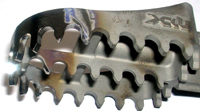Monday
Jan112010
Process for Cleaning and Polishing Nitinol or Titanium
![]()
Minimum recommended process for electropolishing Titanium alloys
- 1. Clean in MicroClean Ti™ (RDZ-1849) (Time and temperature to be determined, no such thing as “too much”)
- 2. Water Rinse
- 3. Alcohol Rinse
- 4. ElectroPolish Ti2 (RDZ-1676), 300+ Amps/ft2, up to 10 minutes
- OR Generic Electropolish (70/30 Methanol/sulfuric) which you can make, or can purchase as Nitinol Titanium ElectroPolish (RDZ-1867), used at 7-10 volts, ~50 Amps/ft2, and below -20 degrees C. If you are making this exciting blend, you may want to read "Control of Methanol-Sulfuric blends".
 In case you were wondering this is NOT a medical device, it is, in fact, a Titanium motorcycle peg. We had a request from a customer to see if we could polish this in the ElectroPolish Ti2™, and although we did not have enough power in the laboratory rectifier to polish the entire peg, it did a nice job on a portion. We keep this as reminder that we can polish things we would never have thought of.
In case you were wondering this is NOT a medical device, it is, in fact, a Titanium motorcycle peg. We had a request from a customer to see if we could polish this in the ElectroPolish Ti2™, and although we did not have enough power in the laboratory rectifier to polish the entire peg, it did a nice job on a portion. We keep this as reminder that we can polish things we would never have thought of.
tagged  processes in
processes in  Medical Equipment Industry
Medical Equipment Industry
 processes in
processes in  Medical Equipment Industry
Medical Equipment Industry 